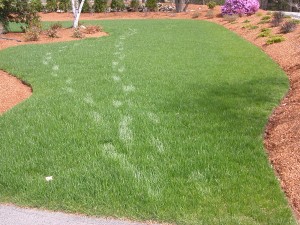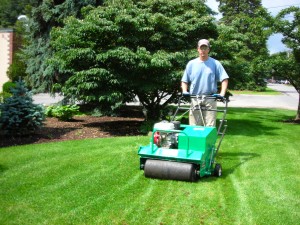Fall Lawn Maintenance
Fall Lawn Maintenance
Your lawn may have some fall maintenance needs depending on how it came out of the summer. Areas that did not come out of summer dormancy due to heat/drought stress or due to disease/insect injury may require rejuvination. How to proceed will depend on the cause or turf decline/death. Evaluation of the affected areas by a turf care professional can be useful to point you in the direction you will need to take.
Lawns that have damage related to heat or drought stress should have soil texture, depth and organic matter content and irrigation strategies evaluated to avoid a repeat of the problems next season. Turf thatch and soil compaction should also be analyzed. If soil conditions are acceptable for turf growth perhaps just a change in irrigation setttings or watering schedules along with an adjustment of cutting height can prevent a repeat of this year’s problem. If your lawn has an irrigation system installed have the zones settings checked and ensure all heads are operating effectively. Settings that are appropriate for spring and fall are usually inadequate for the heat of the summer. For non-irrigated turf attention to cutting height is very important. Begin to cut lawn areas that are subject to drought stress at around 3” in mid to late June before moisture stress becomes evident. The extra height shades the turf more effectively and will reduce soil temperatures and help to conserve soil moisture. Combine this with timely deep waterings to work in harmony with waterings bans and maximize the utilization of water. High amounts of turf thatch ( a tightly bound layer of dead grass, including leaves, stems, and roots, that builds up on the soil surface at the base of the living grass of a lawn) can affect water infiltration and promote shallow rooted turf. A dethatching application may be required to maximize effectiveness of applied/received water. High foot traffic areas or areas that have suffered vehicular compaction often will require core aeration and/or soil ammendment to restore soil structure and improve water perculation. Lawns in full sun without irrigation systems generally require more attention to maintain quality turf.

Figure 2 Increase the cutting height of turf in summer to maximize moisture conservation and reduce turf stress
Fall is a good time to reseed if areas of your lawn have died out over the summer. Fall seeding offers the advantages of reduced weed seed germination, increased frequency of rains and cooler air and soil temperatures as compared to late spring seeding. Choose the right type and blend of grass seed to fit your sunlight conditions. Shadier areas require a higher percentage of fescue mixtures. Resist the urge to try and grow grass in heavily shaded areas. If shady areas are constantly thin and require reseeding it is more practical to plant these areas with shade-tolerant plants. September is an excellent month for fall seeding but can be extended into October if needed. Grass seed will germinate slower when air and therefore soil temperatures start to decrease. Falling leaves can shade grass seed and intefere with seed germination. Try to complete fall seeding by mid October.





